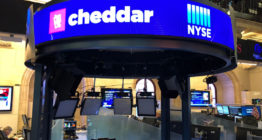CNBC marks 35th anniversary: How financial news has affected broadcasting

Subscribe to NCS for the latest news, project case studies and product announcements in broadcast technology, creative design and engineering delivered to your inbox.
CNBC marked its 35th anniversary April 17, 2024.
The company signed on April 17, 1989, using both the CNBC name and its full name of “Consumer News and Business Channel.”
CNBC has undergone a massive transformation since inception, growing its portfolio exponentially to include 23 hours of live TV programming every weekday across the U.S., Europe and Asia, a round-the-clock digital operation, direct-to-consumer products and an events and councils business.
Today, CNBC reaches more than 450 million consumers worldwide each month.
CNBC has been marking the event with a series of special features and retrospectives shown on air. It also launched a “The More You Know” financial literacy PSA campaign and got a new logo and graphics package late in 2023.
CNBC’s early success sparked interest in other financial news-focused channels, though it wasn’t the first. The Financial News Network, or FNN, launched in 1981 but then was purchased by NBC in 1991 and quickly integrated into CNBC.
CNN ran CNNfn (short for “financial network”) from 1998 to 2004, though it struggled to attract significant viewership (at around the same time, CNN also ran CNNSI, a sports network run in conjunction with its then corporate cousin Sports Illustrated).
Much later, Fox would launch Fox Business in 2007. The network hasn’t gained quite as much popularity as its primary conservative commentary cable channel, but it has remained in operation to this day.
Television financial news offerings also sparked a renewed interest in broadcasting from the floor of the New York Stock Exchange and other exchanges, such as the Nasdaq MarketSite.
For years, it was popular for broadcasters to use booths perched high above the NYSE trading floor, which was often considered too loud and chaotic to broadcast directly from for every hit. However, reports were introduced and TV broadcasters, including CNBC’s “Business Center” broadcast from NYSE floor after trading hours for a period of its run.
In 2016, Cheddar was launched, a digital streaming financial news network. Targeted at a younger audience than CNBC and Fox Business were used to pulling in, the network gradually worked its way up to installing a broadcast booth on the floor of the NYSE in 2017.
While the offering is still in operation it has struggled to maintain revenue streams and its future is somewhat uncertain.
Tickers
TV financial news also became also synonymous with on-screen tickers (named for those old-fashioned machines that spewed out strips of paper with news and financial information on them) showing current trading prices, market standings and other information related to the business and financial world.
CNBC’s blue and white design has changed over the years, but its trademark color scheme has been kept largely the same.
Real-time, data-driven graphics
The broadcast financial news world also had a big influence on real-time data-driven graphics solutions that didn’t need to be rendered — perhaps on par with how advanced election night graphics have become.
These networks needed to be able to display stock quotes that were constantly changing and number in the hundreds. Fullscreen graphics shown as commentators discussed certain companies needed to be able to be pulled up quickly and, of course, show the most current information available.
Of course, some of these technologies improved significantly over the years — CNBC’s original tickers were decidedly more 8-bit style than the clean, crisp text and animation of today.
For some of these features, it took technology some time to catch up, causing some data to be updated by hand.
Using a camera feed to show market averages
The NYSE and other markets also provide a locked-down camera view of the large electronic board mounted in a prominent location. The camera remained pointed at the display and networks could dip into the shot whenever they wanted and needed to be able to display a current average.
Some networks would add an effect that would highlight the key numbers or crop down the feed so that only the most pertinent information was visible. Even in more recent years, this approach is sometimes still used for broadcasters without the ability to link graphics systems to stock quote feeds.
By the way, a similar practice was (and still is) used on some televised basketball games for the shot clock. In the earlier days of TV, graphics systems couldn’t directly integrate into the timing system in the arena, so there were cameras locked down pointed the digital clocks installed near each basket.
When the shot clock was activated, the networks would punch up a cropped version of the live feed, often sized so only the black background and numerals were shown and place it somewhere on-screen.
These approaches, while a bit quaint compared to today’s standards, was nonetheless effective in being able to display real-time information without the ability to link directly into the exchange’s computer system that was determining what figure was shown.
Subscribe to NCS for the latest news, project case studies and product announcements in broadcast technology, creative design and engineering delivered to your inbox.






tags
Cheddar, CNBC, CNNfn, CNNSI
categories
Broadcast Industry News, Heroes